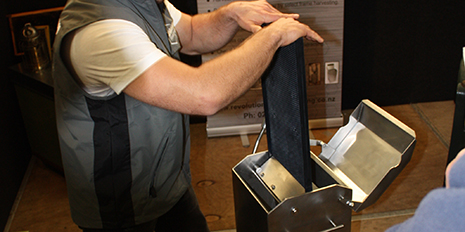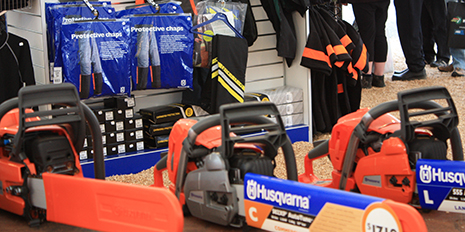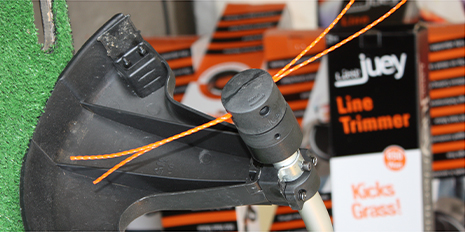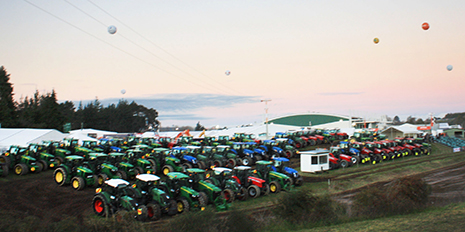
Recently I had the privilege to judge the ‘Launch New Zealand Agritech Innovation Awards’ at the Fieldays, the premier agriculture trade show in New Zealand.
Right here at the very heart of agriculture is where number eight wire thinking originates, and this year was no different. From early raw right through to some well considered and resolved ideas, No.8 Kiwi ingenuity was abundant in the new crop of entries on display within the Fieldays Innovation Centre.
The Fieldays represents a key milestone on the agricultural calendar and it is a great starting point to launch a new product and or gather valuable early feedback. Nowhere else can you get such immediate access to farmers in volume, line up next to other manufacturers and distributors in the same place, and, for newbies, have a go at pitching your ideas for support and investment.

A stand at Fieldays
The organisers have done an excellent job at creating a programme that connects start-up companies and individuals with new ideas. This year all entrants into the innovation awards received a display space within the Innovation Centre. There was the innovation showcase breakfast where the winners were announced, which was later followed by The Den, a dragon’s den pitch-type presentation event which streamed live to screens around the venue. Entrants pitched their ideas to a group of industry players which included Soda Inc, NZTE investment managers, Enterprise Angels from the Bay of Plenty, Gallagher, and James & Wells IP, among others.
Agritech Innovation Awards’
This year’s ‘International Innovation Award’ went to Gallagher for their HR4 Hand Held EID tag reader and tag collector; a user-friendly design which simplifies the task of collecting live animal data on farm (an interesting follow up from the XRS EID Reader 2012 winner). The Grassroots Major Category Award went to the Quad Bike GPS Monitoring System – interesting.
The winner of The Launch NZ Category Award and probably the pick of the winners for me was the Mobile Honey Harvester. This thing is about to change the way honey is collected and handled and it could create a buzz through the beekeeping industry – an industry that appears to have stayed the same for over a century. Grant Engle, a bee keeper himself, has designed a clever mobile stainless steel harvester that enables honey harvesting in the field. This saves time, reduces handling of heavy honey boxes, and reduces contamination and upsetting of the bees. Because it’s small it is ideal for harvesting remote hives where helicopter may be required. Comvita if you are reading, you need to check this out.

The Revolutionary Honey Harvester
And then what about Patrick Roskam, who is only 12; this kid has invented the Gudgeon Pro 4-in-1 fencing device that allows farmers and fencers to drill straight and accurate gudgeon holes to hang farm gates. Patrick said his inspiration came from watching his dad hang 20 gates after which he was very frustrated (he probably did his prunes!). This should be entered into this year’s Young Innovator Awards. Patrick gave a great pitch in The Den and Sir William Gallagher was so impressed he offered him a student summer internship at Gallagher – well done Patrick!
Locus at the Fieldays

Chainsaw protection at he Husqvarna stand
It was pleasing to see a couple of products that we have worked on amongst the products and companies at the Fieldays. Forester, a brand of advanced chainsaw protective wear that we developed with Jaedon Enterprises in 2010 was for sale at the Husqvarna stand, right next to their chainsaw. Husqvarna picked up the product shortly after it went to market and it's great to see it as part of the core Husqvarna offering. A key innovation of Forester is the Fibre Active Chainstopper textile technology that we developed. This won a Bronze Best Design Award and featured here on Campbell Live.

Littl' Juey line trimmer
Littl’ Juey was also there, the ultimate little brand of weed cutting and lawn care devices. Littl’ Juey has been a client of ours stretching back to 2005. Over the years we have worked together on the Little Juey Cutting Heads, the Line Trimmers, packaging and point of sale devices as well as the website. We have also worked on the Reload Cutting Lines which form a core part of the Littl’ Juey system. At the Fieldays this year, Littl’ Juey launched the new Combat Reload Cutting Line. This is a unique nylon line with a twisted profile which makes it cut grass much more efficiently and at a higher rate and volume of grass without the whistle noise that some line trimmers create.
Hotspots & Trends
Having walked the Fieldays and spoken to many, it’s worth finishing off by touching on a few of the emerging trends down farm. It’s clear that the industry, broadly speaking, is all about dairy right now. Every aspect of dairy, from inputs to outputs and effluent waste, are being looked at heavily, with new ideas and suppliers focused at all points through the value chain, and it’s no surprise.

Water supply was an obvious talking point following the severe 2013 summer drought. Water management, storage, and access are a big deal. The focus is now on quantifying water availability and potential water demand at a sub regional or catchment level, and identifying possible strategies to optimise the available water and allow more integrated water management. Water is a critical input for primary production and there is increasing demand for irrigation to sustain as well as to increase yields. The proposed Ruataniwha Basin project in Central Hawke's Bay is worth watching.
Quad bike safety is emerging as a serious issue, one with limited solutions at present and mixed views for and against roll bars and other safety measures. After the string of fatalities and accidents over the summer months, it’s apparent that the message is starting to get through. Four-wheel enclosed vehicles have been adopted by some farmers on flat land, yet the general feeling is that the versatility of the quad bike is what makes it such a core farm utility. The challenge seems to be one of designing a behavioural change in the way farmers manage and protect themselves while riding quad bikes.
With NAIT data collection on farm, getting this information off farm is a big challenge. NAIT is the mandatory National Animal Identification and Tracing scheme. It enables individual animals to be traced and enhances New Zealand’s ability to respond more quickly if there is a biosecurity threat such as a disease outbreak. Cattle and deer are tagged with NAIT approved radio frequency identification device or RFID ear tags and the animal is registered in the NAIT system. This is still early stage; gear (tag and reader) and system (the network) reliability being key. As this develops new opportunities will emerge to make better sense of the livestock related information to improve on-farm practices and production.
Interesting times ahead! Thanks to the organisers and good luck to all those from the Innovation Centre for rolling out your ideas from here.
Comments
Post new comment